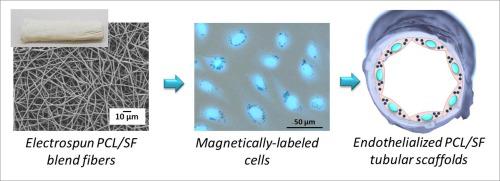当前位置:
X-MOL 学术
›
Eur. Polym. J.
›
论文详情
Our official English website, www.x-mol.net, welcomes your
feedback! (Note: you will need to create a separate account there.)
Optimization of cell seeding on the electrospun PCL-silk fibroin scaffolds
European Polymer Journal ( IF 5.8 ) Pub Date : 2020-07-01 , DOI: 10.1016/j.eurpolymj.2020.109838 Raminder Singh , David Eitler , René Morelle , Ralf P. Friedrich , Barbara Dietel , Christoph Alexiou , Aldo R. Boccaccini , Liliana Liverani , Iwona Cicha
European Polymer Journal ( IF 5.8 ) Pub Date : 2020-07-01 , DOI: 10.1016/j.eurpolymj.2020.109838 Raminder Singh , David Eitler , René Morelle , Ralf P. Friedrich , Barbara Dietel , Christoph Alexiou , Aldo R. Boccaccini , Liliana Liverani , Iwona Cicha

|
Abstract The availability of cell growth- supporting material s for regenerative medicine is limited. Here, we aimed to improve the attachment and growth of endothelial cells (HUVECs) and fibroblasts on electrospun poly(e-caprolactone) (PCL) mats with different fiber diameters and on newly-established PCL and silk fibroin (PCL/SF) blended fibers obtained by using benign solvents (mixture of acetic acid and formic acid) for electrospinning. PCL mats were produced in two different average fiber diameters, namely micro and nano range. The electrospinning method was optimized to produce PCL/SF blended fibers. Morphology (F-actin), viability (calcein) and metabolic activity (WST-8 assay) of HUVECs and fibroblasts cultured in 2D on the mats of different fiber size and composition were compared. Subsequently, cylindrical PCL/SF scaffolds were produced and colonized with cells using 3D radial magnetic cell seeding. Both PCL and PCL/SF nanofibers provided better support for initial cell adhesion (day 1) compared with PCL microfibers. At day 7, the highest metabolic activity in HUVECs and fibroblasts was observed on PCL/SF mats. Microscopic studies confirmed that on day 7, the best support for cell growth was observed on PCL/SF. Tubular PCL/SF scaffolds were successfully colonized using magnetic nanoparticles and 3D radial magnetic cell seeding. Taken together, the fibers obtained by blending SF with PCL combine the mechanical benefits of PCL with improved biological functionality of SF. Electrospun PCL/SF nanofibers represent a promising material to produce both flat and 3D structures with potential for enhanced cell attachment and tissue regeneration.
中文翻译:

电纺 PCL-丝素蛋白支架上细胞接种的优化
摘要 用于再生医学的细胞生长支持材料的可用性是有限的。在这里,我们旨在改善内皮细胞 (HUVEC) 和成纤维细胞在具有不同纤维直径的电纺聚(e-己内酯)(PCL)垫以及新建立的 PCL 和丝素蛋白(PCL/SF)混合纤维上的附着和生长通过使用良性溶剂(乙酸和甲酸的混合物)进行静电纺丝而获得。PCL 垫以两种不同的平均纤维直径生产,即微米和纳米范围。优化静电纺丝方法以生产 PCL/SF 混合纤维。比较了在不同纤维尺寸和成分的垫子上以二维方式培养的 HUVEC 和成纤维细胞的形态(F-肌动蛋白)、活力(钙黄绿素)和代谢活性(WST-8 测定)。随后,使用 3D 径向磁性细胞接种产生圆柱形 PCL/SF 支架并用细胞定植。与 PCL 微纤维相比,PCL 和 PCL/SF 纳米纤维都为初始细胞粘附(第 1 天)提供了更好的支持。在第 7 天,在 PCL/SF 垫上观察到 HUVEC 和成纤维细胞的最高代谢活性。显微镜研究证实,在第 7 天,在 PCL/SF 上观察到对细胞生长的最佳支持。使用磁性纳米粒子和 3D 径向磁性细胞接种成功地定植了管状 PCL/SF 支架。总之,通过将 SF 与 PCL 混合获得的纤维结合了 PCL 的机械优势和 SF 改进的生物功能。电纺 PCL/SF 纳米纤维代表了一种很有前途的材料,可以产生平面和 3D 结构,具有增强细胞附着和组织再生的潜力。
更新日期:2020-07-01
中文翻译:

电纺 PCL-丝素蛋白支架上细胞接种的优化
摘要 用于再生医学的细胞生长支持材料的可用性是有限的。在这里,我们旨在改善内皮细胞 (HUVEC) 和成纤维细胞在具有不同纤维直径的电纺聚(e-己内酯)(PCL)垫以及新建立的 PCL 和丝素蛋白(PCL/SF)混合纤维上的附着和生长通过使用良性溶剂(乙酸和甲酸的混合物)进行静电纺丝而获得。PCL 垫以两种不同的平均纤维直径生产,即微米和纳米范围。优化静电纺丝方法以生产 PCL/SF 混合纤维。比较了在不同纤维尺寸和成分的垫子上以二维方式培养的 HUVEC 和成纤维细胞的形态(F-肌动蛋白)、活力(钙黄绿素)和代谢活性(WST-8 测定)。随后,使用 3D 径向磁性细胞接种产生圆柱形 PCL/SF 支架并用细胞定植。与 PCL 微纤维相比,PCL 和 PCL/SF 纳米纤维都为初始细胞粘附(第 1 天)提供了更好的支持。在第 7 天,在 PCL/SF 垫上观察到 HUVEC 和成纤维细胞的最高代谢活性。显微镜研究证实,在第 7 天,在 PCL/SF 上观察到对细胞生长的最佳支持。使用磁性纳米粒子和 3D 径向磁性细胞接种成功地定植了管状 PCL/SF 支架。总之,通过将 SF 与 PCL 混合获得的纤维结合了 PCL 的机械优势和 SF 改进的生物功能。电纺 PCL/SF 纳米纤维代表了一种很有前途的材料,可以产生平面和 3D 结构,具有增强细胞附着和组织再生的潜力。











































 京公网安备 11010802027423号
京公网安备 11010802027423号